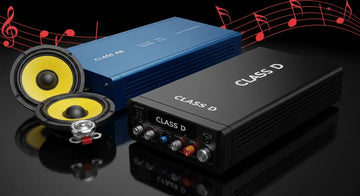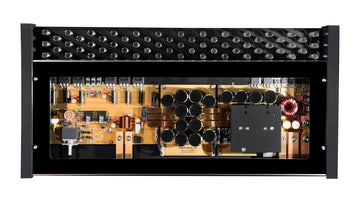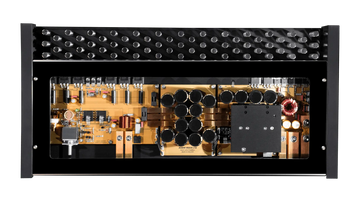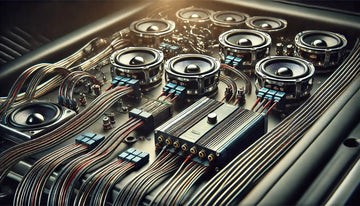Key Highlights
- Class AB amplifiers have the advantages of class A and class B amplifiers, providing high efficiency and reduced distortion.
- The design of class AB amplifiers includes a biasing method to eliminate crossover distortion.
- Class AB amplifiers are commonly used in audio systems, broadcasting, instrumentation, and measurement applications.
- The operating characteristics of class AB amplifiers offer high linearity and efficiency.
- Class AB amplifiers can be designed using MOSFETs for increased power output and efficiency.
- The future trends in amplifier technology include digital advancements and innovations in class AB amplifier design.
Introduction
Class AB amplifiers are a popular choice in audio amplification due to their ability to combine the advantages of class A and B amplifiers. These amplifiers are designed to provide high efficiency while reducing distortion, making them suitable for various applications.
Amplifiers are electronic devices that increase a given input signal's current, voltage, or power. They are often categorized into different classes based on their operating characteristics and mode of operation. Class AB amplifiers are one of the most widely used amplifier classes due to their ability to overcome the limitations of class A and class B amplifiers.
This blog will delve into class AB amplifiers, exploring their design, working principles, applications, and future trends. We will also discuss the key features of class AB amplifiers and how they differ from other amplifier classes. By the end of this blog, you will have a comprehensive understanding of the power and potential of class AB amplifiers.
Understanding Class AB Amplifiers

Class AB amplifiers are a type of power amplifier that combines the advantages of class A and class B amplifiers. These amplifiers are known for their ability to provide high efficiency while reducing distortion, making them suitable for various applications such as audio systems, broadcasting, instrumentation, and measurement.
The Basics of Class AB Amplification
To understand class AB amplifiers, it is essential first to understand the basics of amplification. Amplification is the process of increasing the amplitude of a signal, whether it be voltage, current, or power. It is achieved by using active devices such as transistors, which can control the flow of current and voltage.
Class AB amplification is a technique that overcomes the limitations of class A and class B amplifiers. Class A amplifiers operate in a way that allows the entire input signal to pass through the output stage, resulting in low distortion but low efficiency. On the other hand, class B amplifiers operate by dividing the input signal into positive and negative halves, with each half amplified by a separate transistor. This results in higher efficiency but introduces crossover distortion.
Class AB amplifiers address the issue of crossover distortion by biasing the transistors in the output stage just above the cutoff. This means that each transistor conducts slightly more than half of the input signal cycle, reducing distortion while maintaining high efficiency. The crossover region where both transistors conduct simultaneously helps eliminate the distortion class B amplifiers introduced.
Key Features and How They Work
Class AB amplifiers are characterized by their power output and the use of a complementary pair of output transistors. The power output of these amplifiers depends on the voltage and current capabilities of the output transistors. The complementary nature of the transistors allows one to handle the positive half of the input signal. In contrast, the other handles the opposing half, resulting in more accurate input signal reproduction.
The design of class AB amplifiers includes an output stage that consists of two transistors - one PNP and one NPN type. These transistors are biased just above the cutoff to ensure that they conduct during the transition period between the positive and negative halves of the input signal. This biasing is achieved using diodes connected in series with resistors to control the variations in the emitter-base voltage due to temperature changes.
The amplification process in class AB amplifiers involves the conduction of the input signal by both transistors in the output stage. This eliminates crossover distortion and allows for more accurate input signal reproduction. The class AB amplifier operates in a linear region by applying a small bias voltage using diodes, resulting in a high-quality output signal with minimal distortion.
Design and Construction of Class AB Amplifiers

Class AB amplifiers are designed to achieve high efficiency and reduced distortion by combining the advantages of class A and B amplifiers. Class AB amplifiers' construction involves using a complementary pair of transistors, biasing techniques, and essential components such as power supplies and voltage amplifiers. These amplifiers can be built using a step-by-step guide that includes the design of the input and output stages and the overall amplifier configuration.
Essential Components and Their Functions
The design and construction of class AB amplifiers involve several essential components that play a crucial role in their operation. These components include power supplies, voltage amplifiers, PNP and NPN transistors, and biasing circuits.
Power supplies provide the necessary voltage and current for the amplifier to function. They supply the power required for amplification and ensure that the amplifier operates within its specified range. Voltage amplifiers, on the other hand, amplify the input signal to a level suitable for the amplifier's output stage.
Using PNP and NPN transistors in class AB amplifiers allows for the complementary operation of the output stage. These transistors work together to handle the positive and negative halves of the input signal, ensuring accurate signal reproduction. Biasing circuits, which include resistor diodes, control the voltage and current levels in the amplifier to maintain the desired operating point.
Each component in a class AB amplifier has a specific function that contributes to the overall performance and efficiency. Understanding the role of each component is essential for the design and construction of class AB amplifiers.
Step-by-Step Guide to Building a Basic Class AB Amplifier
Building an introductory class AB amplifier involves a step-by-step process that includes designing and constructing the input stage, output stage, and overall amplifier configuration. These steps can vary depending on the specific requirements and components used in the amplifier design.
The first step in building a class AB amplifier is to design the input stage, which includes the voltage amplifier and any necessary coupling and biasing components. The voltage amplifier amplifies the input signal to a level suitable for the output stage and ensures proper signal reproduction.
Next, the output stage of the amplifier is designed. This stage includes the complementary pair of transistors - one PNP and one NPN type. The transistors are biased just above the cutoff to allow for the conduction of the input signal and eliminate crossover distortion. The output stage is also connected to the power supply and the load, which determines the amplifier's power output.
The overall amplifier configuration is determined once the input and output stages are designed. This includes connecting the input and output stages and additional components, such as filters or feedback circuits. The final step is to test and troubleshoot the amplifier to ensure proper operation and performance.
Building a class AB amplifier requires a thorough understanding of the amplifier design principles and the use of appropriate components. Following a step-by-step guide can help ensure a successful construction process and the desired performance of the amplifier.
Operating Principles of Class AB Amplifiers
Class AB amplifiers operate based on the principles of biasing and conduction of the input signal. These amplifiers are designed to provide high efficiency and reduce distortion by combining the advantages of class A and B amplifiers.
Biasing Techniques for Optimal Performance
Biasing is a crucial aspect of class AB amplifiers as it determines the operating point of the transistors in the output stage. The biasing technique used in class AB amplifiers ensures that the transistors conduct during the transition period between the positive and negative halves of the input signal, eliminating crossover distortion.
Different biasing methods exist for class AB amplifiers, including voltage biasing, voltage divider network, and resistor biasing. Voltage biasing involves direct, independent biasing using a DC voltage supply. This method is simple but not widely used due to packaging and cost limitations.
The voltage divider network biasing method uses resistors to create a voltage drop across the bases of the transistors. This voltage drop biases the transistors above the cutoff and allows for the conduction of a small portion of the input signal. This method is applicable only for specific amplifier configurations and has limited use.
On the other hand, resistor biasing utilizes an adjustable resistance or potentiometer to control the biasing of the transistors. This method provides more control over the biasing and allows for biasing adjustment based on the specific requirements of the amplifier.
Another commonly used biasing method for class AB amplifiers is diode biasing. This method uses diodes to generate a constant voltage drop across the bases of the transistors. The diodes self-adjust the voltage drop based on temperature changes, ensuring stable biasing and reducing the risk of thermal runaway.
Choosing the appropriate biasing technique is essential for optimizing the performance of class AB amplifiers. The biasing method should provide the necessary voltage intervals for the simultaneous conduction of the complementary transistors used in this configuration.
Understanding the Input and Output Stages
The input and output stages play a vital role in the operation of class AB amplifiers. The input stage amplifies the input signal to a level suitable for the output stage, while the output stage amplifies the signal for the desired power output.
The input stage of a class AB amplifier typically consists of a voltage amplifier, which amplifies the input signal to a level suitable for the output stage. The voltage amplifier can be designed using various configurations, such as common-emitter or common-source amplifiers, depending on the specific requirements of the amplifier.
The output stage of a class AB amplifier includes a complementary pair of transistors - one PNP and one NPN type. These transistors handle the positive and negative halves of the input signal, ensuring accurate signal reproduction. The output stage is designed to operate just above the cutoff, allowing for the conduction of the input signal while reducing distortion.
The input and output stages are interconnected to allow for the amplification and transmission of the input signal. The input stage provides the amplified signal to the output stage, amplifying the signal for the desired power output. The output stage is also connected to the power supply and the load, which determines the amplifier's power output.
Understanding the operation of the input and output stages is essential for optimizing the performance of class AB amplifiers. The proper design and configuration of these stages contribute to the overall efficiency and fidelity of the amplifier.
Performance and Efficiency
Class AB amplifiers are known for their high performance and efficiency, making them popular in various applications. The performance of class AB amplifiers is characterized by their linearity, power output, and distortion levels, while efficiency refers to the ratio of output power to input power.
Analyzing the Efficiency of Class AB Amplifiers
Class AB amplifiers are more efficient than class A and B amplifiers. The efficiency of an amplifier is determined by the maximum power output it can handle and the power supply used. Class AB amplifiers are designed to achieve high efficiency by operating in the region between class A and class B amplifiers.
The efficiency of class AB amplifiers is given by the formula Ƞ = π/4 * Vac/Vsupply, where Vac is the AC fluctuation of the output signal and Vsupply is the supply voltage. The maximum efficiency of class AB amplifiers depends on the maximum value of Vac and the location of the operating point.
If the biasing of the class AB amplifier is limited to the cutoff region, the maximum voltage fluctuation is equal to the supply voltage. In this case, the maximum efficiency is Ƞmax = π/4, which is approximately 78.5%. If the biasing is limited to the class A operating point, the maximum voltage fluctuation is half the supply voltage, resulting in a maximum efficiency of Ƞmax = π/8, which is approximately 39.3%.
The efficiency of class AB amplifiers can vary depending on the operating point and biasing techniques used. By optimizing the operating characteristics and biasing methods, it is possible to achieve higher efficiency and better performance in class AB amplifiers.
Comparing Power Consumption with Other Amplifier Classes
Class AB amplifiers offer higher efficiency when comparing power consumption than class A and B amplifiers. Class A amplifiers operate with a continuous current flow, resulting in high power consumption and lower efficiency. Class B amplifiers have higher efficiency but introduce crossover distortion, affecting overall performance.
In contrast, class AB amplifiers overcome the limitations of class A and class B amplifiers by balancing efficiency and distortion. The biasing techniques used in class AB amplifiers ensure that the transistors conduct during the transition period, reducing distortion while maintaining high efficiency.
The power consumption of amplifiers also depends on factors such as load impedance and voltage gain. Class AB amplifiers can be designed with a specific load impedance and voltage gain to optimize power consumption and efficiency. By carefully selecting the components and configurations, it is possible to achieve higher efficiency and lower power consumption in class AB amplifiers than other amplifier classes.
(Table)
|
Amplifier Class |
Power Consumption |
Efficiency |
|
Class A |
High |
Low |
|
Class B |
Medium |
High |
|
Class AB |
Medium |
High |
|
Class C |
Low |
High |
|
Class D |
Low |
High |
Applications of Class AB Amplifiers
Class AB amplifiers find various applications in various industries due to their high performance and efficiency. These amplifiers are particularly well-suited for applications that require high-quality sound reproduction and low distortion.
Popular Uses in Audio and Broadcasting
One of the primary applications of class AB amplifiers is in audio systems, including speakers, headphones, and sound systems. Class AB amplifiers provide high-quality sound reproduction with minimal distortion, making them ideal for music playback and professional audio systems.
Class AB amplifiers are also commonly used in broadcasting, where high-fidelity sound reproduction is essential. These amplifiers ensure accurate signal transmission and reliable performance, making them a preferred choice in radio and television broadcasting.
Class AB Amplifiers in Instrumentation and Measurement
Class AB amplifiers are widely used in instrumentation and measurement applications where precision and accuracy are critical. These amplifiers provide high linearity, low distortion, and high power output, making them suitable for signal conditioning, data acquisition, and sensor amplification applications.
In precision measurement systems, class AB amplifiers ensure accurate signal amplification without introducing additional noise or distortion. They offer excellent signal fidelity and reliability, making them essential components in various scientific and industrial instruments.
The versatile nature of class AB amplifiers makes them suitable for a wide range of applications, from audio systems to instrumentation and measurement. Their high performance, efficiency, and reliability make them a preferred choice in industries requiring signal amplification.
Troubleshooting and Maintenance
While class AB amplifiers are known for their performance and efficiency, they may encounter common issues that require troubleshooting and regular maintenance. Understanding these issues and their solutions is essential for ensuring optimal performance and longevity of the amplifier.
Common Issues and How to Solve Them
Common issues in class AB amplifiers may include distortion, noise, and thermal runaway. Distortion can occur due to improper biasing or component failure, while noise can be caused by poor grounding or interference from external sources.
To troubleshoot distortion issues, it is essential to check the biasing of the transistors and ensure that they operate within their specified range. If biasing is correct, the issue may be related to component failure, in which case the faulty component should be replaced.
Noise issues can be resolved by ensuring proper grounding and shielding of the amplifier. Checking the connections and using high-quality cables can also help reduce noise interference. If the noise persists, it is advisable to check for external sources of interference and isolate the amplifier from them.
Thermal runaway is a common issue in class AB amplifiers. It occurs when the temperature of the transistors increases to a point where they conduct more heavily, leading to further heating and potential damage. To prevent thermal runaway, it is essential to ensure proper heat dissipation and cooling of the amplifier. This can be achieved by using heat sinks, fans, or other cooling mechanisms.
Regular maintenance of class AB amplifiers is essential to ensure optimal performance and longevity. This includes cleaning the amplifier, checking for loose connections, and replacing faulty components. It is also advisable to follow the manufacturer's guidelines for maintenance and seek professional assistance if needed.
Tips for Long-Term Maintenance and Care
Following proper maintenance and care guidelines is essential to ensure the long-term reliability and optimal performance of class AB amplifiers. These tips can help extend the lifespan of the amplifier and minimize the risk of performance issues.
Future Trends in Amplifier Technology
In amplifier technology, future trends are gearing towards even higher efficiency and enhanced performance. Amplifier design innovations focus on optimizing power output while minimizing energy consumption. The integration of digital technology is revolutionizing amplifier enhancement, allowing for precise control and improved sound quality. Recent years have shifted towards more efficient classes like Class D amplifiers, leveraging pulse width modulation for improved efficiency. These advancements are shaping the landscape of amplifier technology, paving the way for smaller, more powerful, and energy-efficient amplifiers that deliver exceptional audio quality. Stay tuned for further developments in this dynamic field.
Innovations in Class AB Amplifier Design
In recent years, class AB amplifier design innovations have focused on enhancing efficiency and performance. One significant advancement is the integration of digital technology to optimize amplifier operation. By incorporating features like pulse width modulation (PWM) and advanced circuit configurations, designers can achieve higher efficiency levels while maintaining audio quality. Another critical trend is using new semiconductor materials for output transistors, improving power output and reducing distortion. These advancements in class AB amplifier design pave the way for more compact, energy-efficient amplifiers without compromising sound quality or output power. Manufacturers are continually exploring new techniques to push the boundaries of amplifier technology.
The Role of Digital Technology in Amplifier Enhancement
Digital technology plays a pivotal role in enhancing amplifier performance. Through innovations like pulse width modulation (PWM) and digital-to-analog converters (DAC), Class AB amplifiers can achieve higher efficiency and improved sound quality. Integrating digital components allows precise control over the amplifier operation, reducing distortion and optimal power output. In recent years, advancements in amplifier design have leveraged digital technology to enhance the overall performance of Class AB amplifiers, catering to the increasing demands for high-quality audio amplification in various applications. Incorporating digital enhancements elevates the capabilities of Class AB amplifiers, ensuring a seamless integration of analog and digital technologies for superior audio output.
Conclusion
Class AB amplifiers offer a compelling balance between the high-fidelity performance of Class A and the efficiency of Class B amplifiers. Their robust design and efficient power usage make them popular in various applications, from audio systems to instrumentation. By understanding the intricacies of biasing techniques and input/output stages, users can optimize the performance of Class AB amplifiers. Despite the recent advancements in Class D and other amplifier classes, Class AB amplifiers remain a reliable choice for many due to their sound quality and moderate efficiency. With ongoing innovations in amplifier technology, the future promises even more efficient and potent Class AB amplifier designs.
Frequently Asked Questions
What Makes Class AB Amplifiers Different from Class A and Class B?
Class AB amplifiers combine the efficiency of Class B and the low distortion of Class A amplifiers. They operate in a way that allows for higher efficiency without sacrificing sound quality, making them a popular choice for audio applications.
Can Class AB Amplifiers Be Used for Professional Audio Systems?
Class AB amplifiers are commonly used in professional audio systems due to their efficiency and high-quality sound reproduction. Their robust design and ability to deliver clean power make them ideal for demanding applications where reliability is crucial.





